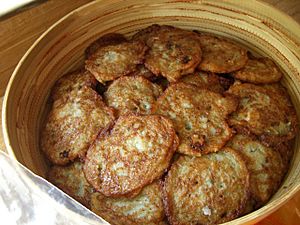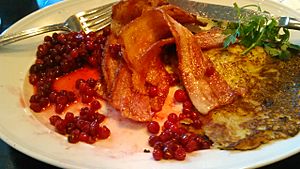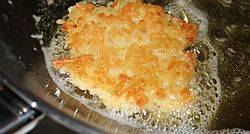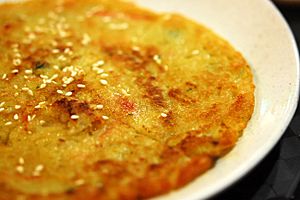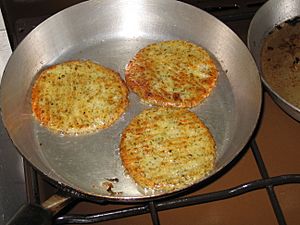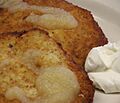Potato pancake facts for kids
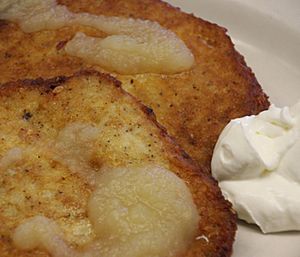
Potato pancakes with apple sauce and sour cream
|
|
| Type | Pancake |
|---|---|
| Region or state | Central, Eastern, and Northern Europe |
| Main ingredients | Potatoes, flour, egg, cooking oil |
Potato pancakes are yummy, flat cakes made mostly from potatoes! They are usually made by grating or grinding potatoes, then mixing them with flour or a binding ingredient like egg. Sometimes, people add flavors like garlic or onion and other seasonings.
These pancakes are cooked by shallow-frying them until they are golden and crispy. You can enjoy them with many different toppings. Some people like savory toppings such as sour cream or cottage cheese. Others prefer sweet toppings like apple sauce or sugar. You can also eat them plain! Sometimes, potato pancakes are even made from mashed potatoes, shaped like pancakes, or made with sweet potatoes for a different taste.
Contents
Potato Pancakes Around the World
Potato pancakes are popular in many European cuisines. You can find them in places like Germany, Austria, Belarus, Poland, and Ukraine. Each country often has its own special name and way of making them.
For example, in Germany, they are called Kartoffelpuffer. In Belarus, they are known as draniki. In Poland, they are called placki ziemniaczane. These pancakes are so loved that they are the national dish of both Belarus and Slovakia!
In Germany, people eat potato pancakes either savory, as a side dish, or sweet with apple sauce, blueberries, sugar, and cinnamon. They are a common treat at outdoor markets and festivals, especially during Christmas markets. In Swiss cuisine, there's a similar dish called rösti, but it doesn't use egg or flour. American hash browns are also made without eggs and flour.
Swedish Potato Pancakes
Sweden has four main types of potato pancakes:
- Raggmunkar: These are made with a pancake batter (wheat flour, milk, egg) mixed with shredded raw potatoes. They are fried in butter and look like thin pancakes called crêpes.
- Potatisplättar: Similar to raggmunkar, but the potatoes are cooked before they are shredded and added to the batter.
- Rårakor: These are more like hash browns. They are made from shredded raw potatoes formed into thin pancakes, but without any batter. They are fried in butter.
- Potatisbullar: These are thicker, patty-like pancakes made from mashed potatoes and eggs. They are coated in breadcrumbs and then fried in butter. You can even buy them ready-made in Sweden!
All four Swedish potato pancake types are usually served with fried bacon and lingonberry jam.
British Potato Cakes
Potato cakes are also popular in the United Kingdom. In the North-East of England, there's a dish called tattie fish. It's named this because the pancake looks like a deep-fried piece of fish! It's made from flour, eggs, shredded potatoes, and onions. Some people add tomato or cheese to the mix.
The British also introduced potato pancakes to their former colonies, like Zimbabwe. They are still eaten there today as an affordable and tasty meal.
Irish Boxty
A special kind of potato pancake called boxty (Irish: bacstaí) is a traditional dish in most of Ireland. It's very popular in certain regions, like north Connacht and southern Ulster. It's made similarly to the British version, but often includes more starch, buttermilk, and baking soda. This gives it a smooth, grainy texture.
Jewish Latke
Latkes (לאַטקע) are potato pancakes that Ashkenazi Jews have made for the Hanukkah festival since the mid-1800s. This tradition started when potatoes became very common and cheap to grow in Poland and Ukraine. Before potatoes were widely available, latkes were made from other vegetables, cheeses, or beans.
Today, many recipes for latkes include ingredients like onions and carrots. You might even find variations with zucchini, sweet onion, or sweet potatoes.
The word latke comes from a Slavic word meaning "small pancake." The Hebrew name for latke is levivah. Some people note that the Hebrew word levav means "heart," which adds a special meaning to the dish.
Korean Gamja-jeon
Gamja-jeon (감자전; lit. "potato pancake") is a Korean pancake. It's made by pan-frying a mix of grated potato and potato starch in oil. Sometimes, people add onion, chili, or perilla leaf to it. It's usually seasoned with a little salt and served with soy sauce.
Polish Placki Ziemniaczane
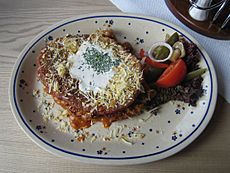
In Poland, potato pancakes are called placki ziemniaczane. They are often served with different toppings like meat sauce, pork crisps, or goulash. You can also find them with sour cream, apple sauce, mushroom sauce, or even fruit syrup.
In the 17th century, Polish monasteries made placki ziemniaczane with onion, eggs, and wheat flour. During tough economic times in the 19th century, potato pancakes often replaced bread for peasants. They were a good way to make lower-quality potato crops taste better and last longer. Their popularity is also linked to the large Jewish community that lived in Poland for centuries.
A very large potato pancake, measuring over 2 meters (about 6.6 feet) across, was made in Rzechta, Poland, during a festival! They even have a fun game there where they throw "bad" potato pancakes, with a record throw of 29 meters (about 95 feet).
Brigand's Pancake
A special Polish dish is made by putting thick goulash on top of a potato pancake. This dish comes from the Tatra mountains, which are on the border of Poland and Slovakia. It has many names, including:
- placek zbójnicki (brigand's pancake) — this is the most common name.
- placek cygański (gypsy's pancake).
- placek węgierski (Hungarian pancake) — even though it's not known in Hungary, the goulash topping does come from there.
- jadło drwali (lumberjacks' food).
- placek góralski (mountainmen's pancake).
Czech Bramborák
A Czech potato pancake is called bramborák. It's made from grated potatoes mixed with egg, breadcrumbs or flour, and seasonings. The most important seasonings are garlic and marjoram, and sometimes caraway seeds. It's usually served plain. Some regional versions might add dough, sauerkraut, or smoked meat. The same potato mix is also used to coat fried pork chops, a dish called kaplický řízek. Sometimes, bramborák is deep fried.
Iranian Kuku Sib Zamini
In Iranian cuisine, kuku sib-zamini (which means 'potato kuku') is a dish made with shredded potatoes, eggs, onion, and saffron. Sometimes, garlic chives and cinnamon are added too. Potato kuku is often cooked as smaller patties, but it can also be made as a larger pancake or baked. This dish is similar to the Jewish latke and the Spanish tortilla Española.
Images for kids
See also
 In Spanish: Kartoffelpuffer para niños
In Spanish: Kartoffelpuffer para niños


